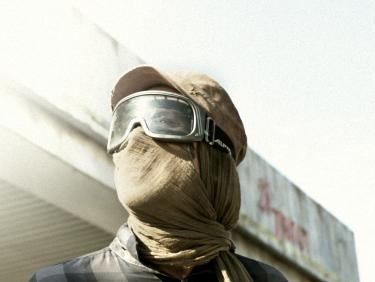The Lighter Side of the Apocalypse – Continuation of the “Apocalyptic Cinema Series”
How would life be on earth if the average temperature would rise by 10 degrees due to the rapid increase of solar storms? Tim Fehlbaum developed an interesting interpretation of these precarious living conditions in his 2011 post-apocalyptic film ‘Hell’ whose screening marked the start of the winter semester‘s Apocalyptic Cinema series.

In contrast to most cinematic post-apocalyptic wasteland scenarios, the film Hell is not situated in the American heartland but, rather, in the Bavarian Forest. Fun fact: the title of the film means ‘bright’ in German and can be understood in both German or English optionally. Surely, either way, the title depicts the storyline of survival after an ecological catastrophe fairly well. The protagonists are in constant search for shade and water in a dry and bright wasteland littered with cadavers. However, as the story continues, the audience realizes that protection from the sun is not the only form of protection needed to survive in this bleached outworld; as the shelter which is finally discovered turns out to be anything but a safe haven. Although, that’s enough spoilers for now.
The film series Apocalyptic Cinema began as an open-air-cinema in the Mathematikon in July 2021 and continues during the winter in cooperation with the Karlstorkino and the DFF - Deutsches Filminstitut & Filmmuseum on the occasion of their special exhibition Catastrophe. What comes after the end?. At each event, a scientific commentary by invited scholars will follow the film screening and we will open up for discussion with the audience afterwards. The first film Hell was screened on November 29th in accordance with the then current COVID-19 regulations of the state of Baden-Württemberg with the 2G+ (vaccinated/recovered + test) rules.
For the start of the series, we were delighted to be able to have Prof. Dr. Olaf Bubenzer from the Institute of Geography at Heidelberg University join us and share his scientific input after the film. He dedicates his research, amongst other areas, to geomorphology, soil science, and drylands in various regions of the planet. From the get-go he demystified the storyline of the film and the overall possibility of a rapid temperature rise on earth (which is within 4 years in the film) due to the higher activity of solar winds. The earth is protected by its geomagnetic field, which keeps our planet and us relatively unaffected by the solar winds. At the moment we only witness solar winds activity in the polar regions of this world as aurora borealis. However, in case of an occurrence such as the 1859 Carrington Event (the most intense solar storm in recent history) happening today, we might see such a storm wreak havoc on our electronics, satellites, GPS, wireless communication systems, and electricity networks.

Moreover, at the earth’s surface, or at the border of our atmosphere, the sun’s radiation arrives as energy with 1360-1365 watts per square meter. Surprisingly enough, between the years of 1980-2015 this energy was almost constant with small fluctuations of merely 3.4%; hence it is also called the ‘solar constant’ and has been in place for millions of years. Prof. Dr. Bubenzer names the eccentricity of the Earth´s orbit (distance between sun and earth at a perihelion of 147.1 million km, and at an aphelion of 152.1 million km) as the main cause for these fluctuations, whereas the 11-year cycle of the sunspots counts for only 0.1% of this variation. Furthermore, the ozone (O3) layer in the earth stratosphere protects us from the sun’s most dangerous short-wave radiation, which keeps, together with the other ingredients of the atmosphere (H2O, O2, CO2), the average surface temperature at 15-16° Celsius. Thus, the sun’s radiation itself cannot be to blame for an ecological catastrophe during humanity’s time on earth as illustrated by the film.
On the other hand, between 1880-2020 the average temperature in our atmosphere rose by 1.1°C due to human greenhouse gas emissions, as well as CO2, methane, and nitrous oxide. In Heidelberg this development was most noticeable with higher temperatures, for example with warm summer months from May until almost October in 2018. An above average number of heat days and warnings as well as tropical nights were documented that year. In combination with lesser summer rainfalls, which also occurred in the following years, this clearly resulted in the ‘drought period` 2018-2020 in Germany. The effects of these droughts can still be examined today in the humidity of the soil. For instance, the deeper soil layers (until 1.8m below surface) has not recovered and been filled up yet in parts of Germany. Undoubtedly, it will need several years to recover fully, which would assume that no further drought years will follow. Prof. Dr. Bubenzer also mentioned the recent report of the IPCC talking about different climate change scenarios till the year 2100 depending on human behaviour.

In the end, Prof. Dr. Bubenzer emphasizes that now we can and must control the temperature rise to be able to prevent passing a tipping point and entering the phase of ‘Hothouse Earth’, where we cannot control it. A possible Hell, indeed.